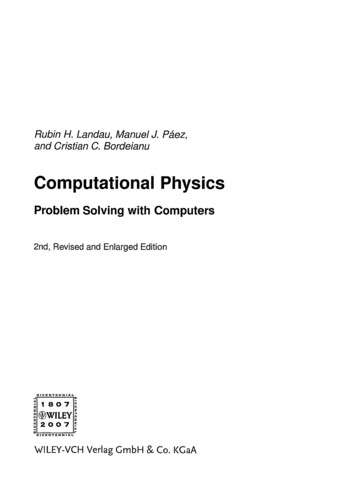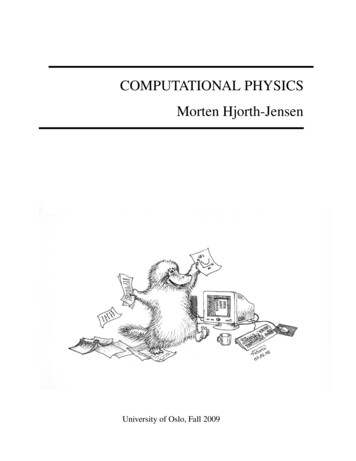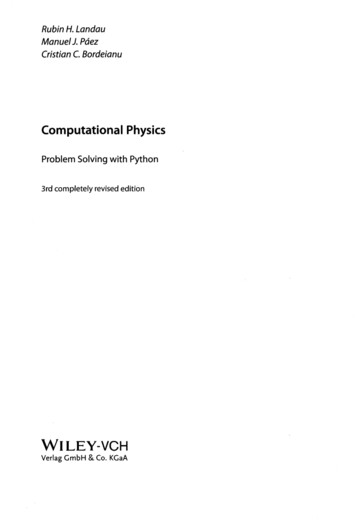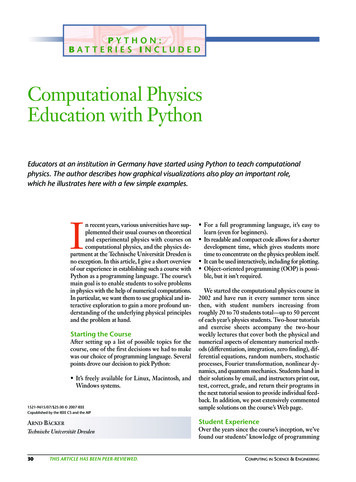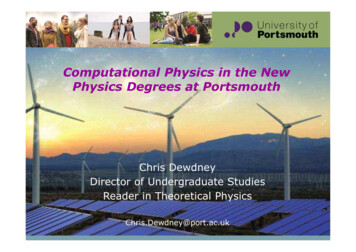
Transcription
Computational Physics in the NewPhysics Degrees at PortsmouthChris DewdneyDirector of Undergraduate StudiesReader in Theoretical PhysicsChris.Dewdney@port.ac.uk
Physics at Portsmouth? Physics delivered at Portsmouth sincethe 1960’sNew BSc Applied Physics – started2010MPhys Applied Physics, MPhys/BScPhysics, Astrophysics and Cosmologystarting September 2015
New labs - 900,000 investment
Applied Physics Physicists contribute a vast amount to theeconomy. Physics-based industry alone employsover 1.79 million people in the UK and contributesover 130bn in export value to the UK economy.2006 –The Independent
PhysicsPhysicsTheory – Experiment – Computation
Applied PhysicsPhysics, Astrophysics andCosmology
Informed by Employers – Industry,Defence, Health Care and CommerceAdoption of Good Practice in HE(HEG,IOP, HESTEM,HEA)8
Vital participation of industry (Industrial AdvisoryBoard)Embed employability skillsDevelop students as independent and cooperativelearnersIntegrate understanding principles of physics withmathematical/computational modelling laboratorywork through problem-based learning.Develop professional practice9
Underdeveloped items Time-management and organisational skills(35%)* Oral presentation (29%)Portsmouth IAB employers agreed. Team working (25%)Great variety of programminglanguages and environments in use Information retrieval(in 2010(20%)*MATLAB most used). Keyrequirement is understanding ofalgorithms andprogramming* Managing own learning(13%)constructs Computing skills (12%) * Ethicalbehaviour(12%)University of Hull/IOP employed graduate survey 2.5years after graduation22 July 2015
Industry ProjectsFinal year (40-credit) joint university-industry projectsintegrating experimental, theoretical and computationalskills and knowledge to design, plan, implement andevaluate a project that addresses specific problems thatarise in the industrial, research and field context.11
IOP support–Higher Education Group–New Degrees Group (Liverpool, Portsmouth,Salford, Leicester, Bradford, St Mary’s(Twickenham))–Industry Group Projects
HESTEM–Curriculum Development Group–Mathematical Modelling and ProblemSolving Group (Mike Savage, Leeds)–Problem-based Learning LaboratoriesAdopters (Derek Raine, Leicester)
Language Learning Learn language syntax Incremental learningand grammar in depthdriven by needs When mastered Learn in specificattempt communicationcontextsVS What do you want to Use immediately tosay?achieve specific ends Progressively developmore sophisticatedmeans of expression.
Computing Options Considered LabVIEW: data acquisition, virtual instrument construction – express VI’sand Visual Progamming – quick and easy in the lab – graphicalprogramming not best for even relatively simple computations.MATLAB: High level, ease of entry, complete environment, many custommodules but introduces dependence, matrix based – (alternative GNUOCTAVE)EXCEL: Good for introducing techniques? e.g. Finite difference methods?Limited computationally. Good for data analysis and presentation andobviously spreadsheets.Visual Basic: Easy construction of GUI’s – VBA in Excel – very slow forcomputations – now droppedC , Java – not the easiest to start with – possibly introduce later.Maple/Mathematica: not a panacea for poor mathematical skills! Needstrong maths basis to use effectively.PYTHON: free – increasing usage (since 2009) – reconsidering now.How I learnt computing
LabVIEW: HeatDiffusionnumericalsolutionHard to review!
Easy to create GUI –virtual instrumentsintegrating numericalsimulation with real-timedata acquisition.
Visual representation of arrays, clearimplementation of element-by-elementoperation and representation of timedevelopment.Limited for “serious” problemsExcel
MATLAB
Computational Units and Integration inthe Curriculum Level 4 Introduction to Computationalphysics Level 5 Computational Physics Level 7 (MPhys) Advanced ComputationalTechniques (2018-2019)
Level 4 “Bottom-up” approach Excel – introduce simple concepts – data manipulation –graphics.Variables and implementation of iterative processes inintuitive and straightforward contexts. Algorithms developedwithout initial mention of DE’s.Limitations of Excel soon encountered. MATLAB – introduce environment – basic text-basedprogramming constructsVariables and implementation of iterative processes inintuitive and straightforward contexts. Algorithmsdeveloped without initial mention of DE’s.Limitations of Excel soon encountered.
Level 4 “Bottom-up” computing labapproachDevelop computationalskills in parallel with themathematical physics skills– no DE’s until TB2Understanding ofderivatives through finitedifferences.No mention ofdifferentialequationsGould and Tobochnik
Steps in Computational Modelling and Problem SolvingStep 1: Problem analysis. Develop an understanding of the nature of the problem. What are the factors that should betaken into account? What software tools are available? What are the key variables and constants? What factors have aninfluence but will not be used in the model?Step 2: Problem statement. Develop a detailed statement of the mathematical model that is to be used to solve theproblem developed. Diagrams may useful.Step 3: Processing scheme. Define the inputs required and the outputs to be produced by the program.Step 4: Algorithm. Design the step-by-step procedure using the top-down design process that decomposes the overallproblem into subordinate problems/tasks. This list of tasks is the structure plan; it is written in pseudocode. The goal is todesign a plan that is understandable and easily translated into a computer language.Step 5: Program algorithm. Translate or convert the algorithm into a computer context (e.g. Excel Spreadsheet, Mapleworksheet, MATLAB program) and debug the syntax errors until the tool executes successfully.Step 6: Evaluation. Test all of the options and conduct a validation study of the computer program, accuracy and e.g. otherprograms, experimental data, theoretical predictions.Step 7: Modification and RevisionBased on: Hahn, B and Valentine, D.T. (2006) Essential Matlab for Engineers and Scientists. Elsevier
Level 4 “Bottom-up” approachHeat transfer –There are many applications on all scales (microchips tolarge machines) in which equipment must be cooled. Oneway of achieving this is through the use of shaped metalconductors in thermal contact with the device that needscooling.The problem is to investigate the process of heat transfer ina conductor. The aim is to construct a computer program tosimulate the processes involved. In the first approach asimple one-dimensional model can be assumed.1.Problem analysisa. What are the physical processes involved?b. How can the processes be calculated?c. What assumptions must be made?Develop computational skills inparallel with the mathematicalphysics skills – no DE’s until TB2
Level 4 units develop knowledge,confidence and understanding ofphysics in industry and research:– Electricity and Magnetism– Space Science and Applicationsof Physics– Mathematical Physics (1&2):incorporates Newtonianmechanics– Introduction to Laboratoryphysics– Introduction to ComputationalPhysics (1) Coordinated approach acrossseparate units: example– Oscillations: mechanicaland electrical–––Laboratory investigations(Pasco data acquisition - LabView systems. Mini PBL.Excel then MATLAB “bottomup” simulationTheory of OrdinaryDifferential Equations inDynamics “top down”– Different PhysicalSituations - samealgorithm – same solution
Group Project: Use of Excel/MATLAB, Wiki’s andModelling process in PBL environment (TB1)Felix set the world record for skydiving an estimated 39 kilometres, 14 October 2012,and became the first person to break the sound barrier without vehicular power onhis descent. Use the 7-step modelling process (see Moodle site) to solve the problem offinding the motion of Felix Baumgartner as he jumped from 39km. Develop a group wiki to present your work. Each step in the modelling processshould have its own wiki page – see Moodle document for how to work with wikis
000300004000050000
Level 5 Core:– Laboratory-based PBL– Thermodynamics andStatistical Physics– Computational Physics– Quantum, Atomic andNuclear– Mathematical Physics– Waves and Optics– Heat transfer–––Laboratory investigationsLabView systems. PBL.MATLAB “bottom up”simulation – finitedifferenceTheory of OrdinaryDifferential Equations inDynamics “top down”– Solving problems in QMusing Maple
Level 5: Laboratory Physics – Problem-based ActiveLearning: Integrated Theory, Experiment andComputer Simulation
Level 7 – Advanced Computationaltechniques (for the future 2018-2019introduction) – “top-down approach”
Effectiveness and Evaluation? Need a systematic assessment andevaluation–Excel - Matlab ?–Problem-based approach – a diversionfrom learning computing techniquessystematically?–Integrated maths/labs/physics/computingPBL’s? Perhaps a basis for a collaborativeproject?
Computational Physics in the New Physics Degrees at Portsmouth Chris Dewdney . PYTHON: free – increasing usage (since 2009) – reconsiderin g now. How I learnt computing. . Steps in Computational Modelling and Problem Solving Step 1 : Problem analysis. Develop an und


